The Rains Are Coming—are your street-side basin inlets, street gutters, roof gutters, and stormwater catchments ready or clogged?
By Brad Lancaster
Like much of the country, drought with high temperatures is drying us out; stressing many shade plants, and threatening our cooling soil-carbon sponges. Yet rain is predicted—so we do all we can to capture and hold on to cooling, life-enhancing moisture.
But even as the summer rains are about to begin in my home of Tucson, Arizona; many people who have installed passive street-runoff harvesting earthworks and/or roof-runoff-harvesting gutters and tanks are NOT ready to receive that free water—because their basin inlets and roof gutters are clogged!
Are YOU ready or clogged?
Street-side tree basin inlets & street gutters
Curb cuts and curb cores enable stormwater runoff from streets to be directed to street-side basins for free irrigation of their plantings and flood control. But, NOT if the are clogged. So, clean them out, along with the upstream street gutter, BEFORE and DURING the rainy season.
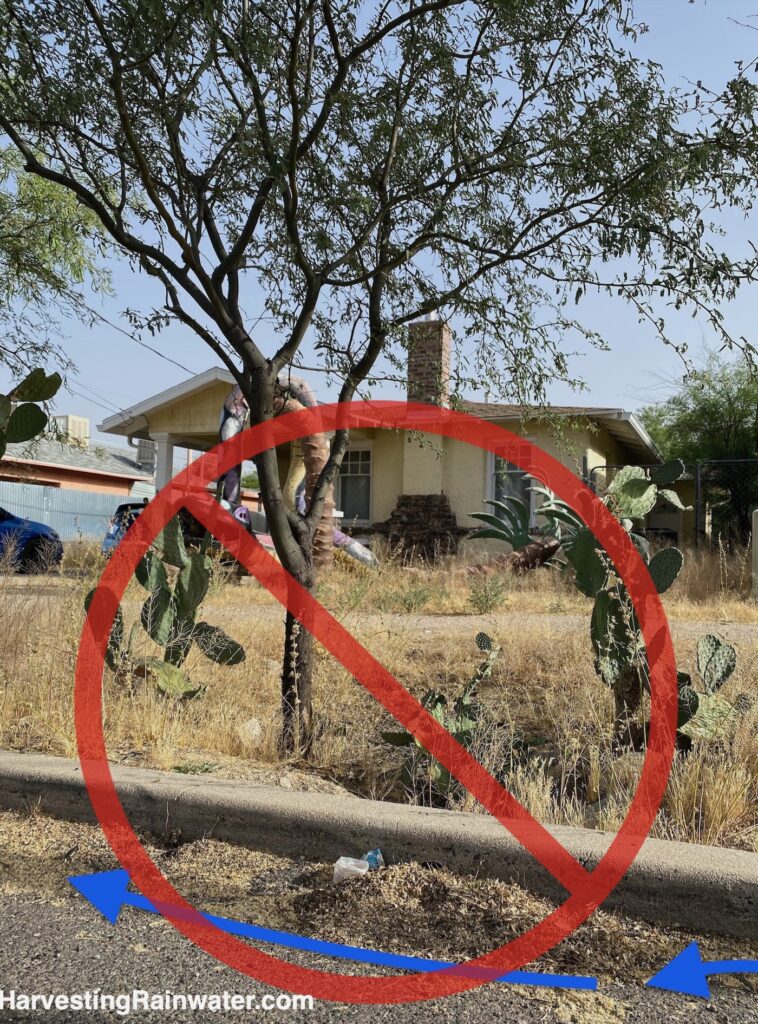
Fix this!
Use shovel to remove debris in street gutter (flat shovel is best), use shovel handle to push debris out of the curb core in street curb.
Blue arrows denote water flow.
Photo: Brad Lancaster
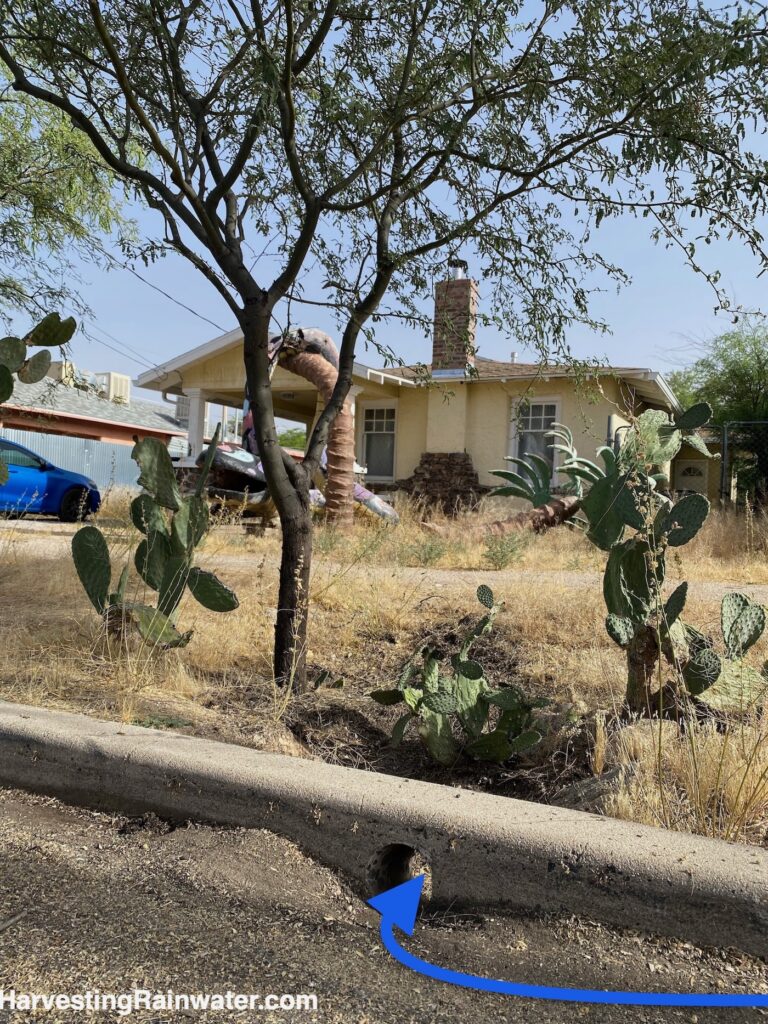
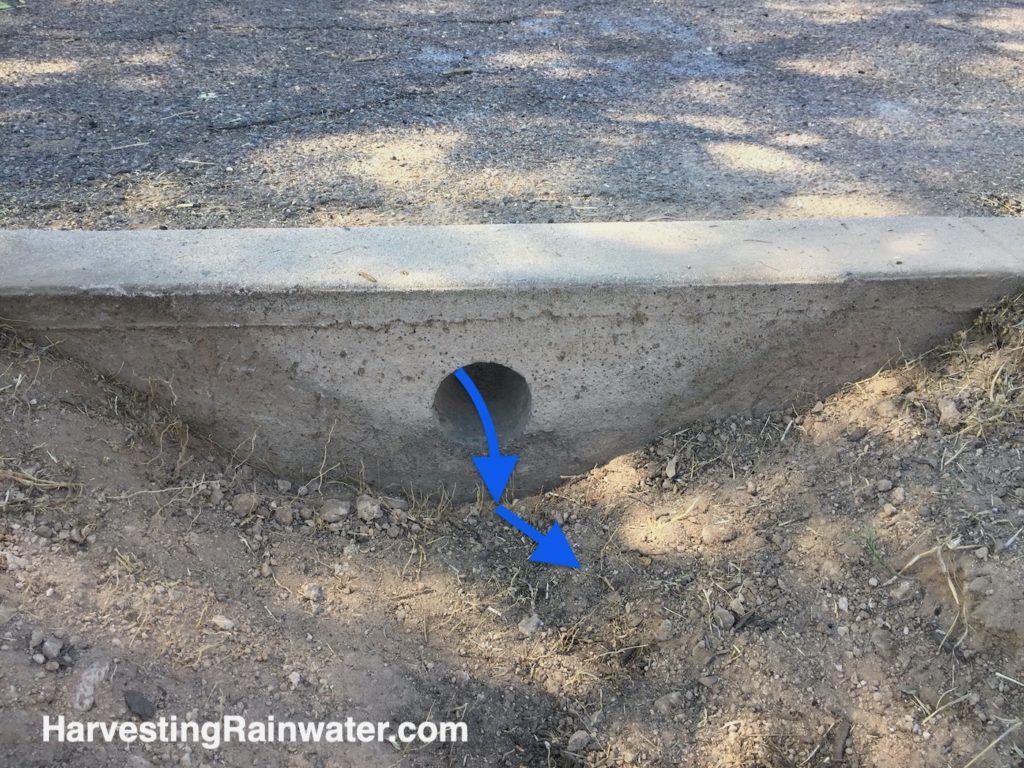
The concrete curb is stained darker from the dirt that was removed with a shovel to prepare the basin to receive the coming rains—there is now at least a 2-inch (50-mm) drop from the bottom of the street-curb core hole (or in another case could be a curb cut) to the top of the soil (or mulch) in the basin.
This way, the flow of the in-coming water will speed up, NOT slow down.
So, sediment carried by the in-coming water will flow through, instead of settling out and clogging, the inlet.
Blue arrows denote water flow.
Photo: Brad Lancaster
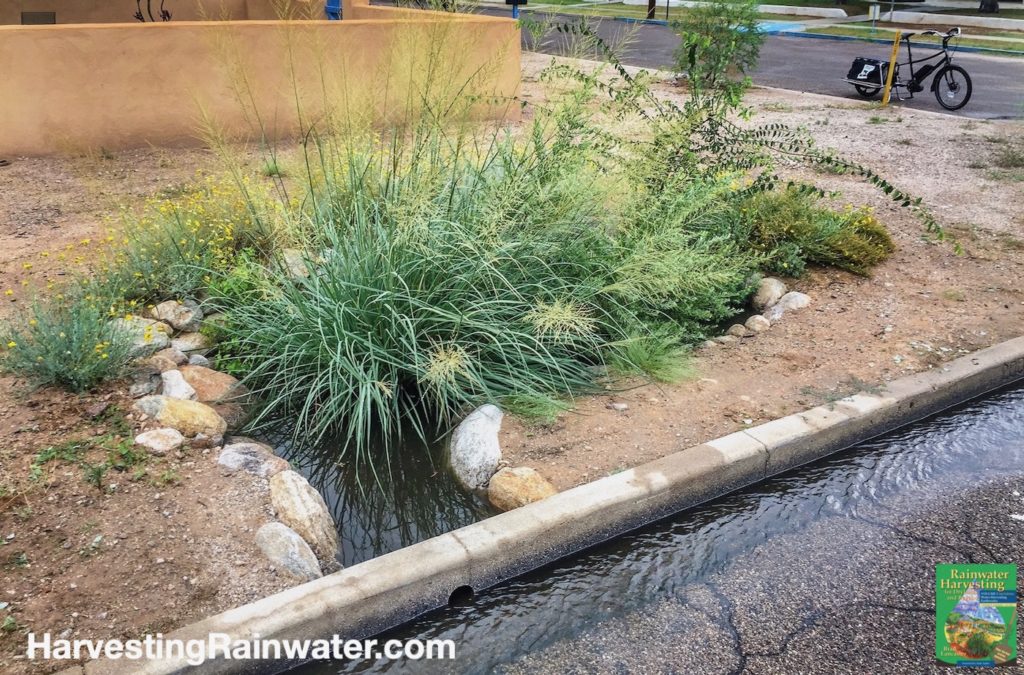
This 8-foot long by 5-foot wide by 1-foot ( 2.4 x 1.5 x 0.3m) deep basin harvests over 5,000 gallons (19,000 liters) of stormwater per year, where only 11 inches (279 mm) of rain per year falls from the sky.
Thus, this street-runoff-irrigated basin provides all the water needs of its vegetation, and will continue to do so once the plants reach their mature size, with surplus water helping recharge the aquifer.
Street gutter water flow is from left to right.
Photo: Brad Lancaster
More important points:
- Water flows downhill, so make sure the elevation of the entire bottom of your street-side basin (and the surface of any mulch within it) is well-below the street gutter and inlet elevation. The deeper the basin the more water you can collect.
- See here for important elevation and slope relationships within street-side basins, and tips on how you can expand their capacity.
- Observe your street-side basin inlets during and after rains, and throughout the rainy season. Clean as necessary.
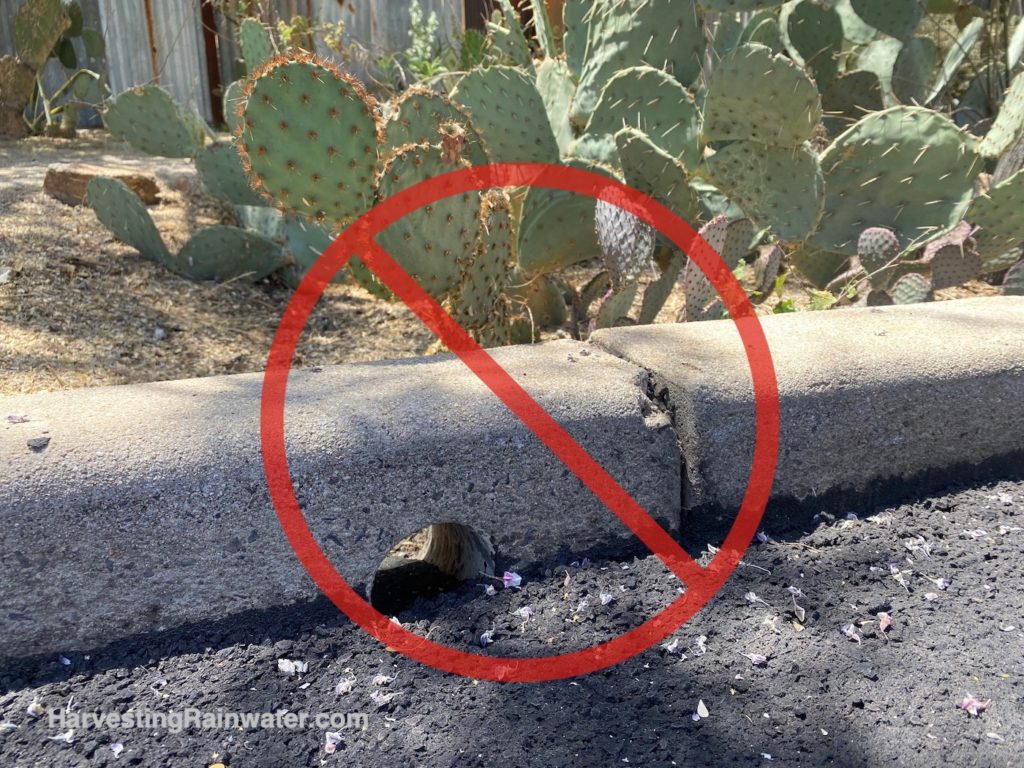
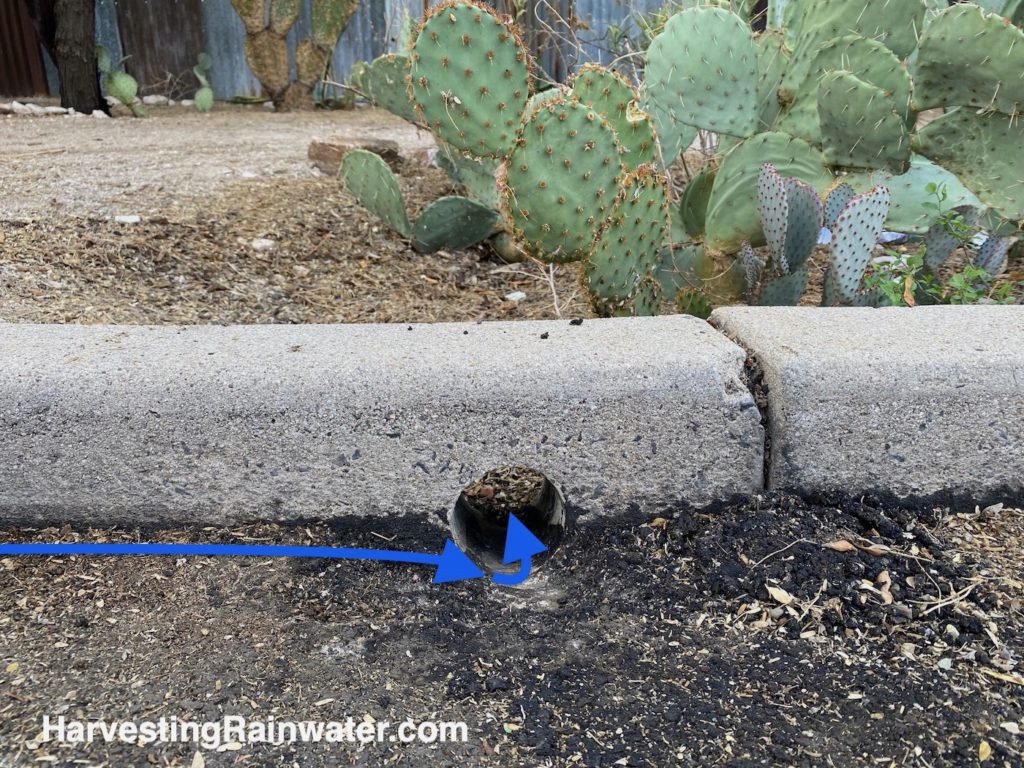
Blue arrows denote water flow.
Photo: Brad Lancaster
Roofs & their gutters
Around the world among rainwater-harvesting cultures, people clean their water catchments before the rain. Children often have this responsibility, sweeping a flat roof- or patio-catchment. At my home, the responsibility is mine.
I have to do this at the beginning of every rainy season because my roof and street gutters fill up with abundant pollen, pods, and leaves from overhanging trees (all of which makes for great soil-building and water-conserving mulch when relocated to the soil’s surface).
If you don’t clean your gutters, you’ll likely lose a lot of water you could’ve otherwise captured.
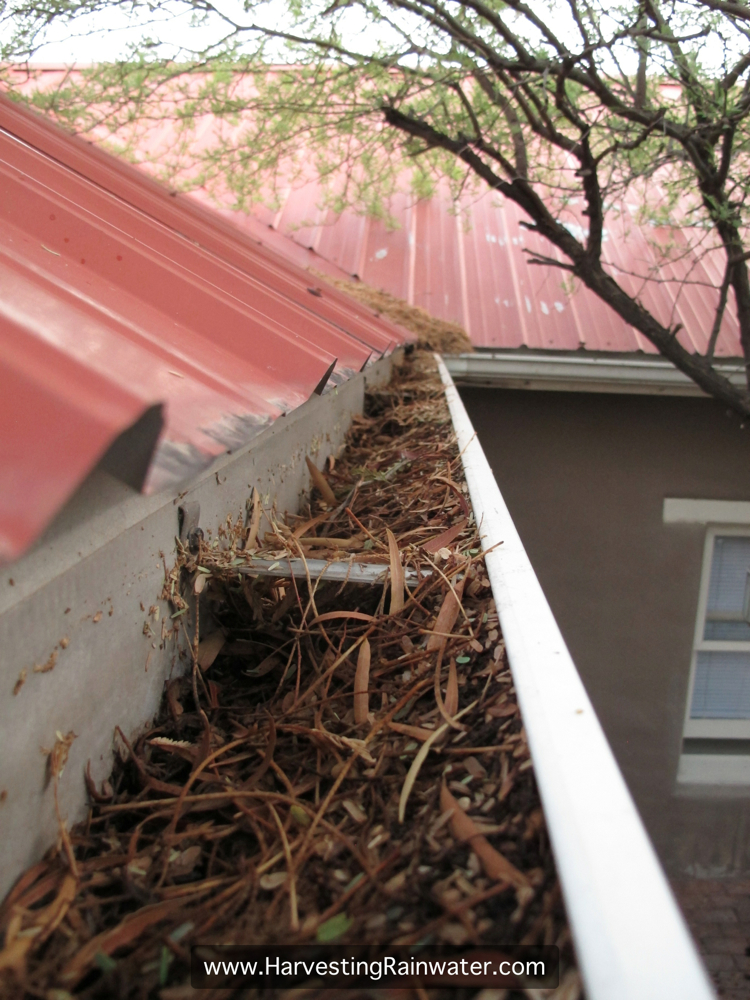
This is a FIRE RISK, as all that organic matter in your gutter will readily burn if there is a fire.
That organic matter will also make your tank water stink for a few weeks if you don’t clean your gutters before the rains begin.
Photo taken at the beginning of the rainy season before gutters were cleaned.
If there is debris on the roof too, clean the roof first, then clean your gutters.
Photo: Brad Lancaster
To help keep the debris collecting in your roof gutters from getting into your rainwater tank install a rainhead downspout inlet screen (and clean your gutters at the beginning of the rainy seasons).
Roof cleaning tool I use
Gutter cleaning tools I use
If I have tree branches overhanging roof and gutter, I first prune the branches as needed so there is at least three feet of clearance between roof and gutter. Then I use:
Wooden bench brush
For easy to access gutters on a low-pitch roof, I get on the roof and use such a brush—nothing else.
Xero gutter gizmo
I use this with its telescoping handle for a less accessible gutter below a metal roof with a steep pitch (a roof I do NOT want to stand on).
I access this gutter from a stable step ladder on the ground.
Orbit telescoping gutter wand
When using this, I divert the organic-matter-laden-gutter-cleaning-water away from my rainwater tanks, because all that organic matter can create a temporary odor to the tank water that lasts a few weeks before the beneficial microorganisms in the tank decompose that organic matter.
I typically use the Xero gutter gizmo to clean out the bulk of the organic matter in the gutter (where I have overhanging tree branches), then I follow up with the gutter wand.
For more…
See the new, full-color, revised editions of Brad’s award-winning books
– available a deep discount, direct from Brad:

Volume 1
Essential reading!
See its eight guiding principles for the harvest of all waters, and an additional ten guiding principles specific to active systems harvesting rainwater in tanks.
Includes simple calculations enabling you to effectively size your systems for maximum performance.

Volume 2
Lots of info on how to create street stormwater-harvesting basins/rain gardens, curb cuts, curb cores and a whole lot more!
Includes simple calculations for ideal sizing of your water-harvesting earthworks, and to estimate their cost of implementation.
